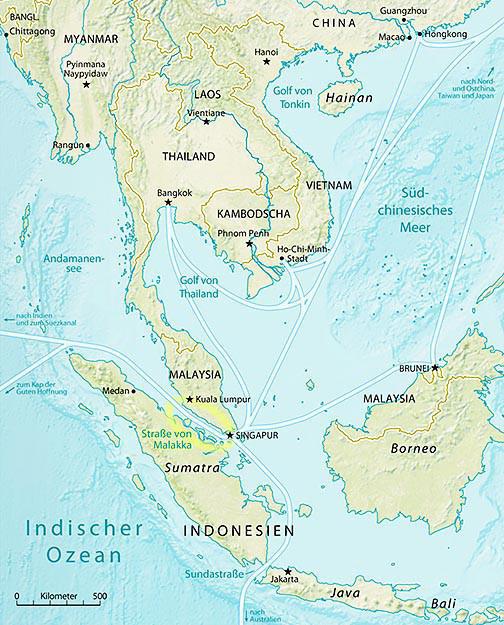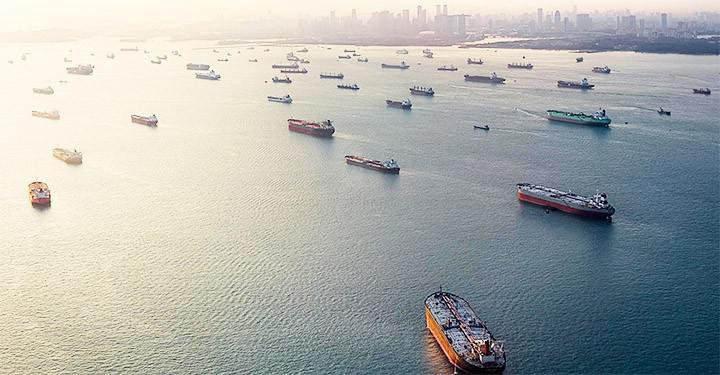The principal trade routes between China and the Middle East, Africa, and Europe pass through the Indian Ocean. The key “bottle neck” of the Chinese maritime cargo transit is the Strait of Malacca
Returning to the topic of the “undeclared war” against Chinese gas, oil, and infrastructure projects in Indochina, let us recall that the armed rebellions of the local tribes in Kachin State and the Kokang autonomous region of Myanmar, which unfolded during the spring of 2015, put the use of China’s already completed gas and oil pipelines, running from the Bay of Bengal to the Yunnan province, under question.
Let us also recall that informed experts link these rebellions to an increase in anti-Chinese activity by US and Taiwanese intelligence, who had established control over the Indochinese Golden Triangle of opium in the middle of the previous century, and who have retained both significant covert resources and significant drug interests in the region.
As Chinese media reports, in response to the military-terrori
This being said, China apparently has no intent of abandoning the use of the pipeline system created in Myanmar, stretching from the Bay of Bengal to the Yunnan province. Shipments of natural gas to Yunnan through Myanmar are of strategic importance to the industrial development of the southern province; moreover, Beijing plans to receive up to 7-8% of its oil imports via the oil pipeline through Myanmar.
In mid-May 2015, the Chinese press reported that tens of thousands of Burmese refugees had fled into the PRC as a result of the fighting in Kachin and Kokang, and that additional Chinese army units have been pulled to the border so as to maintain order in the region.
On June 1st, the Xinhua news agency reported that Chinese forces have begun large-scale, live-fire military exercises on the border with the Burmese Kokang region. On that same day, a PRC Foreign Ministry representative Hua Chunying made the following official statement: “The situation in Northern Myanmar bears on peace and tranquility of the border area. We once again urge parties concerned in Myanmar to exercise restraint, avoid escalating the conflict, and cool down the situation as soon as possible lest security and order along the China-Myanmar border area be jeopardized. It is hoped that Myanmar would join hands with China to safeguard tranquility along the border area and advance the sustained, sound and steady development of bilateral relations.”
So, let this be reiterated, China currently has no intention of abandoning the use of its already constructed pipelines in Myanmar.
However, the situation in the Pakistani province of Balochistan, home to the strategic Gwadar port, now controlled by a Chinese company, and through which the China-Pakistan Economic Corridor (CPEC) is planned to pas, including a gas and oil pipeline, is far from prosperous and stable.
On May 13, a bus full of Ismaili Muslims came under gunfire, killing 46 people and wounding 15. Fighters from the “Islamic State” (Organization banned in Russia) took responsibility for this terrorist act.
On May 25, a terrorist act occurred on the road from Balochistan to Karachi, when a motorcycle loaded with explosives detonated as a motorcade belonging to Suleiman Mamnoon, the president’s son, was passing by. Mamnoon himself was unharmed, but four people were killed, and more than 15 were wounded, including five policemen and innocent bystanders.
On May 29th, unknown gunmen captured two buses with 25 people heading to Karachi from Balochistan’s capital city of Quetta. The terrorists gunned down 19 hostages and released six.
As one can see, the Chinese projects for oil and natural gas transit from the Persian Gulf region and Africa via pipeline branches of the “New Silk Road” through Pakistan and Myanmar are facing serious obstacles. But, China’s demand for oil and natural gas continues to grow.
This means that China would have to receive most of its imports by sea via oil and gas tankers. And clearly, China can afford to abandon neither oversea energy resource shipments, nor maritime transport of other goods (bulk cargo, container shipments, etc.), which remains the cheapest option.
However, as we previously discussed in our investigation, the principal trade routes between China and the Middle East, Africa, and Europe pass through the Indian Ocean. The key “bottle neck” of the Chinese maritime cargo transit is the Strait of Malacca.
This long (more than 800km) and narrow (2.5km wide near Singapore) strait between the Malay Peninsula and the island of Sumatra is one of the highest intensity “sea arteries” on the planet. 3 billion tons per year, or one quarter of the world’s sea freight passes through this strait, which connects the Indian and Pacific Oceans.
The strait is full of shallow spots and strong and unpredictably changing currents. This in and of itself presents a serious challenge to navigation and passage of ships through the strait, even with the help of skilled local pilots. According to expert assessments, the strait may reach its maximum transit capacity, approximately 120,000 vessels per year, in the next 2-3 years.

Since the strait frequently finds itself covered with thick smoke from forest fires on Sumatra, serious “traffic jams” often occur as a result, causing ships to move very slowly and to remain anchored while waiting for their turn to pass through the more hazardous areas.
The list of nuisances would not be complete without mentioning the pirates flourishing in the strait, requiring the owners of ships to either bring a powerful guard detail on the voyage, or to hire one on the spot. But most important of all, this crucial transport artery of the Strait of Malacca can be reliably blocked at any moment.
It can be blocked as a result of a terrorist attack; it would be sufficient to sink one or two large ships in a narrow and shallow spot of the water way to halt traffic entirely and for a protracted period of time. It can also be blocked for certain countries in the event of a military conflict, if a naval blockade for the merchant vessels of these countries were to be set up at the exits from the strait.
China understands this perfectly, especially after the US reached an agreement with Singapore in 2012 to continuously deploy its stealthy Littoral Combat Ships to patrol the strait’s exit into the South China Sea. Furthermore, the US reached another agreement with the Philippines in 2013 to re-establish its naval bases, along with ones under joint control with Japan, providing them with a “guest presence”.
Perhaps it is because of this that China has one again returned to discussing and planning a project to create a sea canal from the Andaman Sea to the South China Sea, passing the Strait of Malacca through the Malay Peninsula’s Kra Isthmus.
China first proposed building this “Thai Canal” in negotiations with Thailand a decade ago, in 2005. The Thai government, headed at that time by an ethnic Chinese representative of the Hakka sub-ethnicity, Thaksin Shinawatra, responded by showing great interest. However, the United States began fervently resisting the canal’s construction. An armed coup deposed Thaksin Shinawatra in 2006, and negotiations around building the canal came to a standstill.
In 2011, Thaksin Shinawatra’s younger sister, Yingluck Shinawatra and her “Pheu Thai” (For Thailand) party won the parliamentary elections, and she became the prime minister. After this, talks with Beijing resumed around the “Thai Canal”, and a proposal was put on the table for a high-speed railroad branch of the “New Silk Road” passing through Laos, Thailand, and Malaysia on the way to Singapore.
However, a military junta ousted Yingluck Shinawatra from power in May 2014 as a result of yet another coup d’etat. “The international community”, including both leading European nations and the United States, harshly condemned the “crude violation of democratic principles” in Thailand, essentially putting Thailand’s military dictatorship into a state of international isolation. The topic of the “Thai Canal” was once again put on hold.
But, as it came to light in the spring of 2015, the topic of the canal wasn’t put entirely on hold. For the Thai military, apparently, the prospects of having a strategic alternative to the Strait of Malacca on their territory, along with the consequent transit dividends, was an idea way too lucrative to overlook. But… the Thai military also had no desire to irreversibly ruin its relations with the “international community”, already tenuous ever since the coup. Therefore, the canal became no longer the topic of international negotiations, but rather of “private enterprise”.
In February and March of 2015, reports appeared on the Internet and in the press regarding the interest of certain unnamed Chinese and Thai companies in building the canal; moreover, the planned route of the canal through the Kra Isthmus near Thailand’s border with Malaysia, has long been the site of detailed engineering surveys.
Finally, on May 18, 2015, the Hong Kong newspaper Oriental Daily reported that the privately-owned China-Thailand Kra Infrastructure Investment & Development Co Ltd and Asia Union Group Co Ltd signed a memorandum of understanding in the Chinese city of Guangzhou regarding the future construction of the Thai Canal.
(To be continued…)
Source (for copy): https://eu.eot.su/?p=9248
This is the translation of the thirteenth article (first published in “Essence of Time” newspaper issue 131 on June 10, 2015) by Yury Byaly of a series on the new round of global economic warfare. The ultimate goal of this war, of which gas wars is a part, is the weakening and dissolution of Russia. But disruption of Russian supply of gas will lead to lack of gas and rise of prices and some European economies might just not handle this. Since all of the global economy is intertwined, those who started this war want to make not just Russia, but many other countries become weaker in the end.




